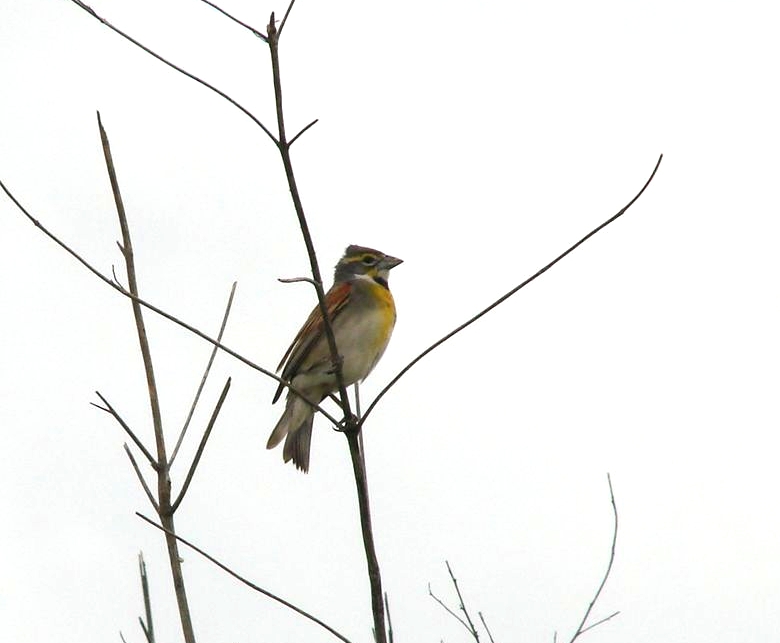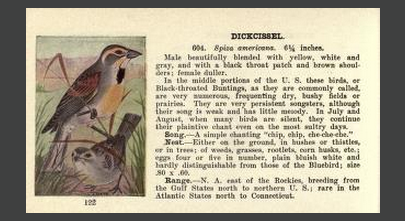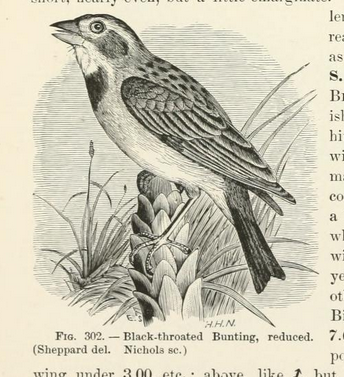If you think about the English names of American birds, they fall neatly into two groups: folk names and book names.
“Turtle dove” for Zenaida macroura is a familiar and still current example of the first, “northern rough-winged swallow” an obvious instance of the second.
Some birds, like the Henslow’s sparrow, have only book names, while others have both. In the case of a few common and conspicuous birds, the book name is identical to one of the folk names; think “blue jay.”
When I was a young birder, I assumed that “dickcissel” was one of those, too, a name of “the people” taken over into the books when they finally came to be written.
I think I was wrong.
My suspicion now is that “dickcissel” is a book name and only a book name, invented not by a farm boy in a hot summer hayfield but by an ornithologist in his study.
And I think I know who.
I spent the first nineteen years of my life living in dickcissel country, and would later pass another nine in the very heart of that species’ abundance. Neither in southeast Nebraska nor in east-central Illinois did I ever hear a non-birder refer to the little brown sparrowy thing on the wire as a “dickcissel” — or, tellingly, by any name at all. This bird is just not big enough or colorful enough or conspicuous enough to have intruded on the visual and aural horizon of the non-specialist.
In fact, a search of the usual suspects turns up very few certain folk names for the dickcissel at all. Wilson tells us that Bartram’s “May bird” refers to this species, but presents no evidence (“Of this bird I have but little to say”!), and Bartram himself appears never to have prepared a description, simply listing “Calandra pratensis, the May bird” as occurring within the regions covered in his Travels.
Writing about the bird’s status and habits in Illinois, Alfred O. Gross claimed that “dickcissel” was “the bird’s common name,” without, however, explaining just what a “common” name might be.
He also, more interestingly, wrote in 1921 that
in the Middle West it is popularly and generally known as the “Little Meadowlark,” a name that has arisen because of its resemblance in miniature to the common Meadowlark. Indeed, some very intelligent farmers believe the Dickcissels to be merely small individuals of the larger and well known bird.
That name dates to at least 1860, when J.M. Wheaton reported that in Ohio the bird was known as the “little field lark.” This notion survived into Roger Tory Peterson’s field guides, where the dickcissel was said from the very start to be “suggestive of a tiny Meadowlark.”
I remember asking the old folks about that forty years ago — and getting nothing but blank stares in reply from people who still unselfconsciously used names like “rain crow,” “chimney bat,” “wild canary,” “brown thrush,” and “turtle dove.”
Deep down, I doubt that the dickcissel — small, brown, and flighty — ever had a widespread folk name; but if it did, then I’ll believe Wheaton and Gross that it was something like “little meadowlark.”
Book names, by their very nature, are much easier to trace.
In 1783, John Latham’s General Synopsis, the basis for Gmelin’s description and naming of the species, uses the straightforward name “black-throated bunting,” the English moniker retained by Gmelin, Thomas Pennant, Wilson, Bonaparte, Audubon (including the Synopsis and the octavo edition), Thomas Nuttall (both editions), Baird, Cassin, George Lawrence, Thomas Brewer, T.S. Roberts, C.J. Maynard, and Elliott Coues — the last from at least 1861 to (d’outre tombe) 1903.
Other naturalists not native speakers of English gave the bird similar names. Maximilian von Wied-Neuwied adhered to the Latham pattern when he called it “schwarzkehliger Ammer [“Ammer” is consistently masculine for the prince] mit gelber Brust,” the black-throated bunting with a yellow breast. Vieillot, too, names the bird “black-throated,” “la passerine à cou noir, Passerina Nigricollis.”
The first seeds of change were sown in 1874. The History of Baird, Brewer, and Ridgway still called it “black-throated bunting,” but in that same year, the junior author of that work reported that in Illinois the bird was known as the “Judas bird” and — at long last — “dickcissel.”
The replacement of the older name was slow in coming. The bird was still the black-throated bunting in the Auk as late as 1885. Even Ridgway himself would not adopt “dickcissel” as the species’ formal name for some time. In 1881, he was still calling it the black-throated bunting in the Nomenclature.
In 1886, though, it was over. Ridgway apparently managed to persuade his fellow committee members to assign our prairie thick-bill the English name “dickcissel” in the new Check-list of the young AOU. Almost immediately, almost everyone — with the signal exception of Elliott Coues — fell into nomenclatural line. Ridgway’s Manual of 1887 uses only “dickcissel,” as would henceforth the Auk. Wells Cooke compromised in 1888 by using both names, but it was just plain “dickcissel” for him, too, soon enough.
Well before the turn of the twentieth century, the name “black-throated bunting” was almost gone. Perley Milton Silloway could write in 1897 that this bird had once
received a book name suggested by the distinctive markings … the black-throated bunting; but so few knew him by that title and so many of his friends were familiar with his earnest exhortation, that he was given the name sounded in the notes he utters, and is now Dickcissel.
So it has remained — and that explanation, that the name “dickcissel” is echoic of the bird’s song, remains current, too. The only problem is — you knew there had to be a problem — that the transliteration of the song as “dick, dick – cissel” appears to postdate Ridgway’s name. In other words, I do not believe that the name “dickcissel” comes from the bird’s song, but rather that the claim that those syllables are heard in the song is the imaginative and retroactive justification for the bird’s odd name. Seriously: do you hear “dickcissel” in that song?
Elliott Coues didn’t either. You’ll remember that he alone among the great American ornithologists of the period after 1886 held on to the old name “black-throated bunting.” His entry in the Century Dictionary s.v. “dickcissel” tells us subtly why: that name is
said to be imitative.
“Said to be.” Coues didn’t believe it either, and a look at the pre-Ridgway literature on this species reveals that no one had come up with anything remotely like “dickcissel” in discussing the song. Here is Wilson in 1808:

Vieillot, who may or may not have known the bird in life, says exactly the same thing:
The song of the male seems to express the syllables chip, ché; the first is repeated twice in a row, slowly; the second is repeated three times and very quickly.
This “chip, chip, che-che-che” persisted at least a hundred years, from Wilson into the days of Chester Reed.
Audubon, too, comes up with nothing remotely resembling the bird’s modern name:
(I doubt that Audubon is describing the right bird here at all; corn bunting song much more closely resembles the long warbled song of a grasshopper sparrow than the buzzy stutter of a dickcissel.)
I’d be very happy for earlier attestations, of course, but the first time I run into the song of Spiza transliterated in the modern way is 1893, 20 years after Ridgway first sprang the name on the ornithoworld:
While some other birds are equally numerous, there are few that announce their presence as persistently…. All day long, in spring and summer, the males… perch upon the summits of tall weed-stalks or fence-stakes, at short intervals crying out: See, see,-Dick-cissel, cissel….
And the author of those words? Robert Ridgway.
I suspect that Ridgway himself, dissatisfied for whatever reason with the business-like “black-throated bunting,” invented the name “dickcissel,” which appears to be unattested before he communicated it to Coues in 1874. I think, too, that Ridgway — perhaps, just remotely perhaps spurred by Coues’s rejection of the name over the next quarter of a century — came up with the tendentious transliteration of the bird’s song to justify his name, a proceeding that has given rise to a whole short chapter of “fakelore” about the dickcissel’s place in American folk culture at the end of the nineteenth century.
Sadly, sadly, this is the sort of thing that can be argued only ex silentio. But until the shade of Robert Ridgway (or of one of those very intelligent Illinois farmers) tells me otherwise, I think I know what kind of name “dickcissel” is.
A contrived one. And I’m pretty sure I know who did it.













